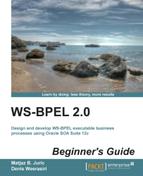In the previous chapter, we introduced three bookstores into our composite BPEL application, BookstoreA, BookstoreB, and AnotherBookstore. Let's now modify the conditions in the <if> activity, where we select the bookstore with the lowest book quantity. We have to compare three book quantities of stores in the BookstoreAResponse, BookstoreBResponse, and AnotherBookstoreResponse variables. To access the BookstoreAResponse quantity, we should use the following XPath expression:
$BookstoreAResponse.payload/ns1:StockQuantity
Similarly, we would access the BookstoreB and AnotherBookstore stock quantities.
To select the lowest quantity, we should do the following comparisons:
- Compare the
BookstoreAstock quantity toBookstoreBandAnotherBookstore. If theBookstoreAstock quantity is lower or equal in both cases, selectBookstoreA. - Compare the
BookstoreBstock quantity toBookstoreAandAnotherBookstore. If theBookstoreBstock quantity is lower or equal in both cases, selectBookstoreB. - Compare the
AnotherBookstorestock quantity toBookstoreAandBookstoreB. If theAnotherBookstorestock quantity is lower or equal in both cases, selectAnotherBookstore.
Let us now implement this in BPEL:
- We will need three branches. For the first, we will use
<if>and for the other two, we will use<elseif>. As with the three branches, we have covered all possibilities, and so we will not use the<else>activity in this case:
- Let us now add the conditions. Right-click on the first if, select Edit, and enter the condition as shown in the following screenshot:

- In a similar way, you should add the other two conditions.
We have implemented the condition for selecting the bookstore with the lowest stock quantity. To get a better understanding, we should switch to the source code and carefully review it. To check whether BookstoreA has the lowest stock quantity, we have defined the following condition:

To check whether BookstoreB has the lowest stock quantity, we have defined the following condition:

To check whether AnotherBookstore has the lowest stock quantity, we have defined the following condition:

Note
Please note that in the preceding code, we have used the < entity, which is used in XML to represent the < sign, which cannot be used directly. The same holds true for >, which is represented as >. For more information on XML and HTML entities, please refer to http://en.wikipedia.org/wiki/List_of_XML_and_HTML_character_entity_references.
We have successfully added three complex conditions to our process. To demonstrate the conditions even better, we will introduce a new service called Vintage Bookstore in the next section.
Let's extend our example and add VintageBookstore. The VintageBookstore service will be responsible for selling older books. Older books are the books published before 1970. We will define a conditional branch, based on the publishing year of the book. The BPEL would look like this:
<if>
<condition>
xp20:year-from-dateTime($inputVariable.payload/client:BookData/
client:PublishingYear) < 1970
</condition>
<!-- perform activities for books older than 1970 -->
<else>
<!-- perform activities for books published 1970 or after -->
</else>
</if>